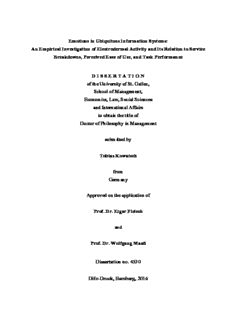Table Of ContentEmotions in Ubiquitous Information Systems:
An Empirical Investigation of Electrodermal Activity and Its Relation to Service
Breakdowns, Perceived Ease of Use, and Task Performance
D I S S E R T A T I O N
of the University of St. Gallen,
School of Management,
Economics, Law, Social Sciences
and International Affairs
to obtain the title of
Doctor of Philosophy in Management
submitted by
Tobias Kowatsch
from
Germany
Approved on the application of
Prof. Dr. Elgar Fleisch
and
Prof. Dr. Wolfgang Maaß
Dissertation no. 4530
Difo-Druck, Bamberg, 2016
The University of St. Gallen, School of Management, Economics, Law, Social Sciences and
International Affairs hereby consents to the printing of the present dissertation, without
hereby expressing any opinion on the views herein expressed.
St. Gallen, May 30, 2016
The President:
Prof. Dr. Thomas Bieger
II
Dedicated to my family.
II I
IV
Acknowledgments
First and foremost, I am greatly indebted to my PhD supervisors, Prof. Dr. Elgar
Fleisch and Prof. Dr.-Ing. Wolfgang Maaß, for their wise guidance, visionary
thoughts, and hands-on attitude. They have shared their knowledge and experi-
ence, and I deeply appreciate every discussion we had. Second, I would like to
express my gratitude to Sabine Janzen, Andreas Filler, Julian Eichhoff, Dr. Peter
Mayer and Dr. Flavius Kehr for being the best officemates one could imagine.
Particularly the huge effort of Sabine Janzen and Andreas Filler allowed me to
conduct the empirical studies of the current work. Also, I would like to thank
Asst.-Prof. Dr. Felix Wortmann for being a highly supportive discussion partner,
and John Christensen for his highly critical, but incredibly helpful proofreading.
Many thanks also to Elisabeth Vetsch-Keller, Sonja Baumgartner, Ruth Meier and
Jeannette Strompen for making my life at the University so pleasant. And my grat-
itude also goes out to all the other friends and colleagues who have accompanied
me over the course of the past four years: Lukas Ackermann, Gabriella Chiesa,
André Dahlinger, Niklas Elser, Gunnar Fleisch, Dr. Gundula Heinatz, Dr. Edward
Ho, Asst.-Prof. Dr. Alexander Ilic, Dr. Thorben Keller, Marcus Köhler, Jan-Niklas
Kramer, Asst.-Prof. Dr. Maximilian Palmié, Dr. Irena Pletikosa, Dr. Matthias Raf-
felsieper, Paul Rigger, Prof. Dr. Thorsten Staake, Dr. med. Ioannis Tarnanas, Dr.
Verena Tiefenbeck, Dr. Dirk Volland, Fabian Wahle, Dr. Markus Weinberger.
Most importantly, however, I am deeply grateful to my parents Elfriede and
Anton Kowatsch, along with my grandparents Maria and Heinrich Halbherr, for
their unconditional love and encouragement. Last but not least my love and words
of gratitude go out to my dear wife Martina and our children Lisa-Marie and
Rosalie for their never-ending affection, support, and empathy.
Tobias Kowatsch, February 2016
V
VI
Table of Contents
Acknowledgments ............................................................................................ V
List of Tables ................................................................................................. XII
List of Figures ............................................................................................. XVII
Abstract ..................................................................................................... XXIII
Abbreviations ............................................................................................. XXV
1 Introduction ............................................................................................... 1
1.1 On the relevancy of ubiquitous information systems ..................................... 1
1.2 In situ responses to UIS stimuli by electrodermal activity ............................. 2
1.3 Research questions and contributions to NeuroIS research ........................... 5
1.4 Theoretical framework ................................................................................. 11
1.5 Mixed methods in design science research .................................................. 13
1.6 Structure and logic of the remaining chapters .............................................. 14
1.7 Summary ....................................................................................................... 14
V II
2 Related Work .......................................................................................... 17
2.1 Ubiquitous Information Systems .................................................................. 17
2.2 Design science research ................................................................................ 20
2.3 Perceived characteristics of information technology ................................... 23
2.4 Neuro-Information-Systems research ........................................................... 27
2.5 Electrodermal activity in homeostatic regulation ......................................... 33
2.6 Measurement and parameters of electrodermal activity ............................... 37
2.7 Review of related work utilizing electrodermal activity .............................. 44
2.8 Summary ....................................................................................................... 62
3 Research Model and Hypotheses ........................................................... 65
3.1 Stimulus-Organism-Response paradigm ...................................................... 66
3.2 Two-systems view of cognitive processing .................................................. 71
3.3 The stimulus: breakdown of a UIS service ................................................... 79
3.4 Physiological arousal and the generalization effect ..................................... 88
3.5 Perceived ease of use and physiological arousal .......................................... 92
3.6 The behavioral response: task performance ................................................. 95
3.7 Summary ....................................................................................................... 98
4 Method ................................................................................................... 101
VIII
4.1 IKS, SiDIS and the evaluation of UIS services .......................................... 101
4.2 Identifying the ticket order service as the focal UIS service ...................... 105
4.3 Making the case for three similar ticket order services .............................. 110
4.4 Procedure of the single- and repeated-exposure studies ............................. 115
4.5 Observational, physiological and psychological measures ........................ 125
4.6 Summary ..................................................................................................... 130
5 Results .................................................................................................... 133
5.1 Pretest, data quality, problematic cases and outliers .................................. 133
5.2 Demographics and descriptive statistics ..................................................... 135
5.3 Internal validity of instruments and empirical data .................................... 139
5.4 External validity with respect to gender and age differences ..................... 147
5.5 PLS-SEM, sample size considerations and planned analyses .................... 156
5.6 Assessment of the measurement models .................................................... 161
5.7 Evaluation of the structural model and hypotheses .................................... 165
5.8 Assessing the higher-order construct ease of use ....................................... 175
5.9 Summary ..................................................................................................... 188
6 Discussion .............................................................................................. 191
6.1 Sensitivity of electrodermal activity ........................................................... 191
IX
6.2 Reliability threat because of generalization effects .................................... 197
6.3 Conceptualizing electrodermal activity as physiological arousal .............. 202
6.4 Physiological arousal complementing perceived ease of use ..................... 208
6.5 Limitations of the current work .................................................................. 214
6.6 Future research ........................................................................................... 217
6.7 Summary ..................................................................................................... 221
Bibliography .................................................................................................. 229
Appendix A: List of publications from NeuroIS.org ................................. 283
Appendix B: Publications utilizing parameters of electrodermal
activity as a result of the literature review ......................................... 293
Appendix C: Promotion cards of the studies .............................................. 301
Appendix D: Instructions for the supervisor of the studies ...................... 303
Appendix E: Study information for participants ....................................... 309
Appendix F: Constructs and questionnaire items ..................................... 313
X
Description:Information and communication services have become ubiquitous in our everyday life and, in turn, research on Ubiquitous Information Systems (UIS) has received increasing attention. UIS services can elicit both negative and positive emotions, which are not necessarily perceived consciously by individ

